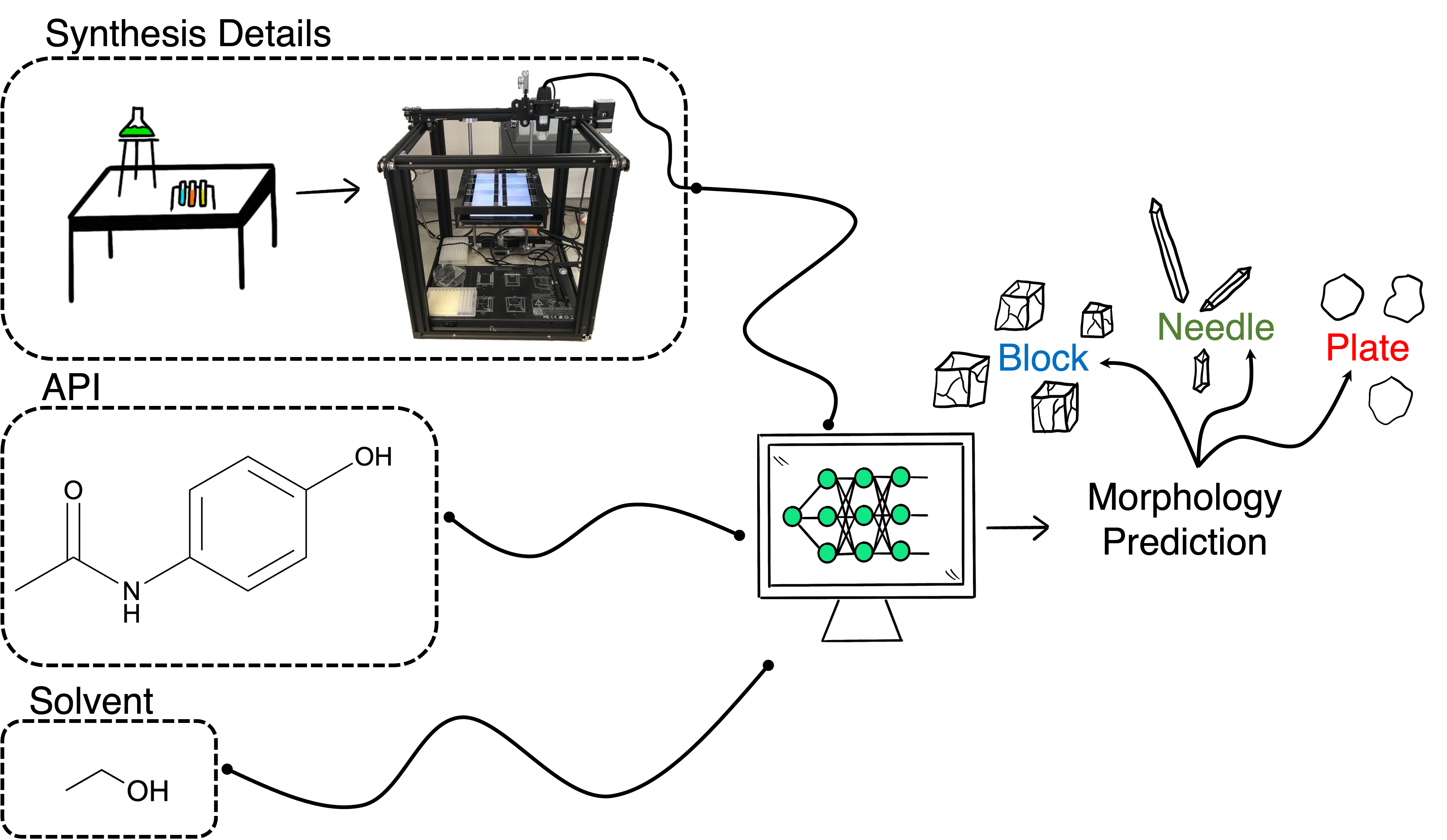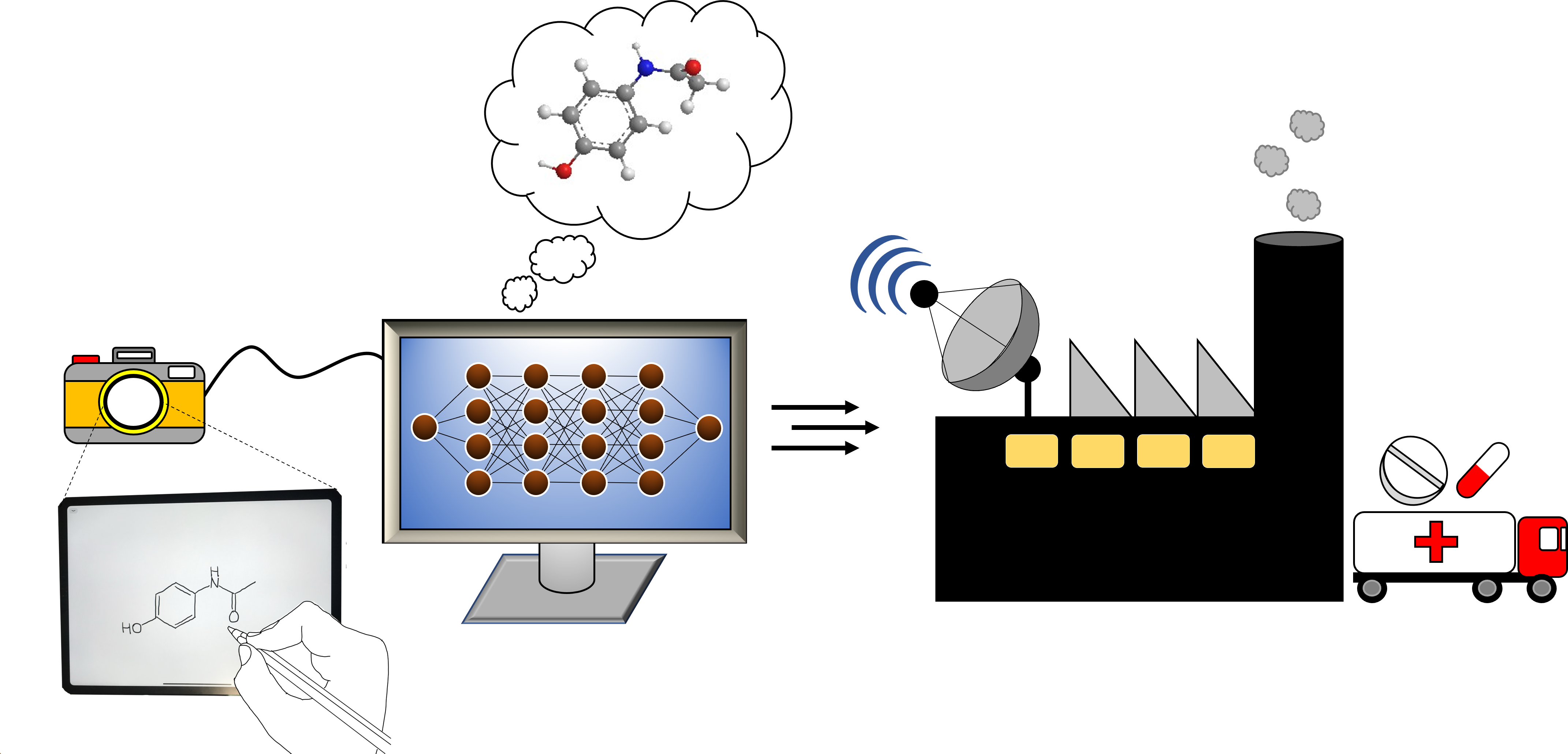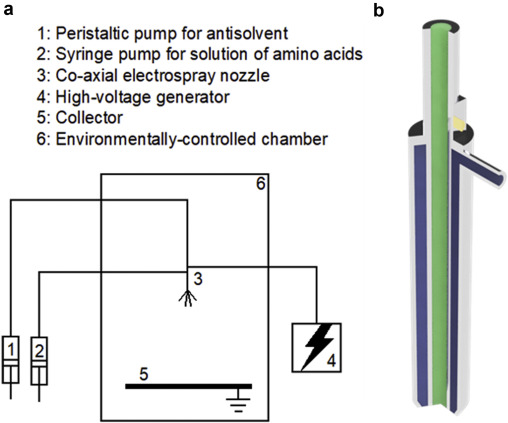Journal Articles
On this page is a collection of all the journal articles I have worked on. There is a short description of the project and some personal reflection about the project. For technical details, please follow the link at the bottom of each paper!
2022
Predicting Pharmaceutical Crystal Morphology Using Artificial Intelligence
 This work is the publication that directly
reflects the initial aim of my PhD, which was morphology prediction using AI. It builds upon my "Images of Chemical Structures as
Molecular Representations for Deep Learning" paper directly. The work assesses the state of morphology prediction
using open source data. Following this we address limitations through in house experimental work using experimental screening
and robotics. As a result of better molecular representations, transfer learning and more curated data, we improve upon
the the prediction accuracy of models trained on publicly available data.
This work is the publication that directly
reflects the initial aim of my PhD, which was morphology prediction using AI. It builds upon my "Images of Chemical Structures as
Molecular Representations for Deep Learning" paper directly. The work assesses the state of morphology prediction
using open source data. Following this we address limitations through in house experimental work using experimental screening
and robotics. As a result of better molecular representations, transfer learning and more curated data, we improve upon
the the prediction accuracy of models trained on publicly available data.
Reference:
Wilkinson, M.R., Martinez-Hernandez, U., L. K. Huggon et al. Predicting Pharmaceutical Crystal Morphology Using Artificial Intelligence,
Accepted manuscript CrystEngComm 2022. https://doi.org/10.1039/D2CE00992G
Go to Paper
Images of Chemical Structures as Molecular Representations for Deep Learning
 This project was my first publications as the lead author!
In chemical applications of AI, it is important to get the information about molecules into a machine readable form. This is more trivial
across other areas where you can work with tables of numbers, images or even encoded categories. With molecules however, capturing important details
as inputs a computer can actually use is more difficult, especially when you consider we are working in an environment where there are
quite literally infinite inputs. Here, we tried just drawing the molecules and then using deep learning for computer vision. We assessed against other
common molecular representations and the images performed much better.
This work was also presented at the MRS spring meet conference. You can watch the talk using the button below!
This project was my first publications as the lead author!
In chemical applications of AI, it is important to get the information about molecules into a machine readable form. This is more trivial
across other areas where you can work with tables of numbers, images or even encoded categories. With molecules however, capturing important details
as inputs a computer can actually use is more difficult, especially when you consider we are working in an environment where there are
quite literally infinite inputs. Here, we tried just drawing the molecules and then using deep learning for computer vision. We assessed against other
common molecular representations and the images performed much better.
This work was also presented at the MRS spring meet conference. You can watch the talk using the button below!
Reference:
Wilkinson, M.R., Martinez-Hernandez, U., Wilson, C.C. et al. Images of chemical structures as molecular representations for deep learning. Journal of Materials Research 37, 2293–2303 (2022). https://doi.org/10.1557/s43578-022-00628-9
Go to Paper
See Conference Video
2020
Concurrent Antisolvent Electrospraying: A Novel Continuous Crystallization Technique
 This paper was the first publication I was ever a part of!
In a strange "in at the deep end" moment, in the early months of my PhD, my supervisor suggested we
attempt what he called "a paper in a week". Hence, each of the authors on the publication were members of the group
at the time. The work looked to combine antisolvent crystallization with electrospraying, the latter being
a continuous crystallization method our group had been working on. We each took on differing parts, mine being
the old-school anti-solvent crystallization and the SEM imaging. I also developed some code to help
normalize the PXRD patterns autonomously, without lots of tinkering on Excel. Given this was my first few weeks of programming,
and having seen "Automate the boring stuff" advertised to me often, this seemed a fairly appropriate
introduction to programming.
This paper was the first publication I was ever a part of!
In a strange "in at the deep end" moment, in the early months of my PhD, my supervisor suggested we
attempt what he called "a paper in a week". Hence, each of the authors on the publication were members of the group
at the time. The work looked to combine antisolvent crystallization with electrospraying, the latter being
a continuous crystallization method our group had been working on. We each took on differing parts, mine being
the old-school anti-solvent crystallization and the SEM imaging. I also developed some code to help
normalize the PXRD patterns autonomously, without lots of tinkering on Excel. Given this was my first few weeks of programming,
and having seen "Automate the boring stuff" advertised to me often, this seemed a fairly appropriate
introduction to programming.
Reference:
Perge, L, Gr ̈ols, J, Segura, D.F, Al-Ani, A, Wilkinson, M, Castro-Dominguez, B, Concurrent Antisolvent
Electrospraying: A Novel Continuous Crystallization Technique, Journal of Pharmaceutical Sciences, (2020),
https://doi.org/10.1016/j.xphs.2020.06.023
Go to Paper!
Images of Chemical Structures as Molecular Representations for Deep Learning
 This project was my first publications as the lead author!
In chemical applications of AI, it is important to get the information about molecules into a machine readable form. This is more trivial
across other areas where you can work with tables of numbers, images or even encoded categories. With molecules however, capturing important details
as inputs a computer can actually use is more difficult, especially when you consider we are working in an environment where there are
quite literally infinite inputs. Here, we tried just drawing the molecules and then using deep learning for computer vision. We assessed against other
common molecular representations and the images performed much better.
This work was also presented at the MRS spring meet conference. You can watch the talk using the button below!
This project was my first publications as the lead author!
In chemical applications of AI, it is important to get the information about molecules into a machine readable form. This is more trivial
across other areas where you can work with tables of numbers, images or even encoded categories. With molecules however, capturing important details
as inputs a computer can actually use is more difficult, especially when you consider we are working in an environment where there are
quite literally infinite inputs. Here, we tried just drawing the molecules and then using deep learning for computer vision. We assessed against other
common molecular representations and the images performed much better.
This work was also presented at the MRS spring meet conference. You can watch the talk using the button below!
Reference:
Wilkinson, M.R., Martinez-Hernandez, U., Wilson, C.C. et al. Images of chemical structures as molecular representations for deep learning. Journal of Materials Research 37, 2293–2303 (2022). https://doi.org/10.1557/s43578-022-00628-9
Go to Paper
See Conference Video
2020
Concurrent Antisolvent Electrospraying: A Novel Continuous Crystallization Technique
 This paper was the first publication I was ever a part of!
In a strange "in at the deep end" moment, in the early months of my PhD, my supervisor suggested we
attempt what he called "a paper in a week". Hence, each of the authors on the publication were members of the group
at the time. The work looked to combine antisolvent crystallization with electrospraying, the latter being
a continuous crystallization method our group had been working on. We each took on differing parts, mine being
the old-school anti-solvent crystallization and the SEM imaging. I also developed some code to help
normalize the PXRD patterns autonomously, without lots of tinkering on Excel. Given this was my first few weeks of programming,
and having seen "Automate the boring stuff" advertised to me often, this seemed a fairly appropriate
introduction to programming.
This paper was the first publication I was ever a part of!
In a strange "in at the deep end" moment, in the early months of my PhD, my supervisor suggested we
attempt what he called "a paper in a week". Hence, each of the authors on the publication were members of the group
at the time. The work looked to combine antisolvent crystallization with electrospraying, the latter being
a continuous crystallization method our group had been working on. We each took on differing parts, mine being
the old-school anti-solvent crystallization and the SEM imaging. I also developed some code to help
normalize the PXRD patterns autonomously, without lots of tinkering on Excel. Given this was my first few weeks of programming,
and having seen "Automate the boring stuff" advertised to me often, this seemed a fairly appropriate
introduction to programming.
Reference:
Perge, L, Gr ̈ols, J, Segura, D.F, Al-Ani, A, Wilkinson, M, Castro-Dominguez, B, Concurrent Antisolvent
Electrospraying: A Novel Continuous Crystallization Technique, Journal of Pharmaceutical Sciences, (2020),
https://doi.org/10.1016/j.xphs.2020.06.023
Go to Paper!
2020
Concurrent Antisolvent Electrospraying: A Novel Continuous Crystallization Technique
 This paper was the first publication I was ever a part of!
In a strange "in at the deep end" moment, in the early months of my PhD, my supervisor suggested we
attempt what he called "a paper in a week". Hence, each of the authors on the publication were members of the group
at the time. The work looked to combine antisolvent crystallization with electrospraying, the latter being
a continuous crystallization method our group had been working on. We each took on differing parts, mine being
the old-school anti-solvent crystallization and the SEM imaging. I also developed some code to help
normalize the PXRD patterns autonomously, without lots of tinkering on Excel. Given this was my first few weeks of programming,
and having seen "Automate the boring stuff" advertised to me often, this seemed a fairly appropriate
introduction to programming.
This paper was the first publication I was ever a part of!
In a strange "in at the deep end" moment, in the early months of my PhD, my supervisor suggested we
attempt what he called "a paper in a week". Hence, each of the authors on the publication were members of the group
at the time. The work looked to combine antisolvent crystallization with electrospraying, the latter being
a continuous crystallization method our group had been working on. We each took on differing parts, mine being
the old-school anti-solvent crystallization and the SEM imaging. I also developed some code to help
normalize the PXRD patterns autonomously, without lots of tinkering on Excel. Given this was my first few weeks of programming,
and having seen "Automate the boring stuff" advertised to me often, this seemed a fairly appropriate
introduction to programming.